January 27, 1983
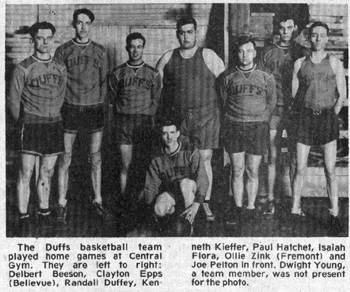
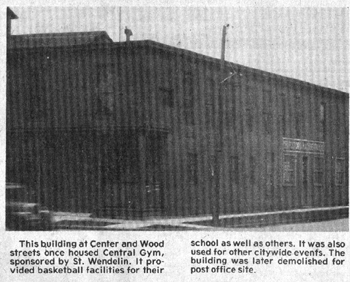
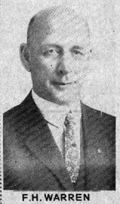
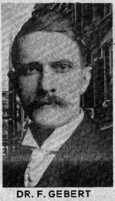
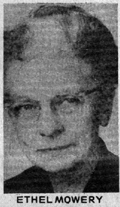
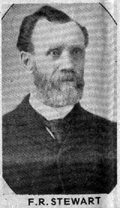
Picture #1 – The Duffs basketball team played home games at Central Gym. They are left to right: Delbert Beeson, Clayton Epps (Bellevue), Randall Duffey, Kenneth Kieffer, Paul Hatchet, Isaiah Flora, Ollie Zink (Fremont) and Joe Pelton in front. Dwight Young, a team member was not present for the photo.
Picture #2 – This building at Center and Wood Streets once housed Central Gym, sponsored by St. Wendelin. It provided basketball facilities for their schools as well as others. It was also used for other citywide events. The building was later demolished for post office site.
Picture #3 – Ken Kieffer, the 350-pound guard on Duffs basketball team, provided pre-game entertainment, as shown in photo.
Picture #4 – F.H. Warren
Picture #5 – Dr. F. Gebert
Picture #6 – Ethel Mowery
Picture #7 – F.R. Stewart
Recently I saw “Scotty” McDermid in the bank and he said when he read the West Center Street series he was reminded of the Central Gymnasium that was once located in part of the factory across from the YMCA where the post office is now.
He said, “You remember it don’t you, Paul?” I guess he detected a blank look on my face as he talked about the basketball games played there when we were in high school. I had to admit I did not have the faintest recollection of that gymnasium.
He must have thought I doubted his memory or truthfulness, so he said, “Ask Joe Blaser or John Lee, they will remember since they played basketball there”.
According to McDermid, the gymnasium was started by St. Wendelin Parish since they did not have a gym and the high school was not yet constructed.
So, I did ask Blaser and Lee, not that I didn’t believe “Scotty”, but it was difficult for me to understand why I didn’t know about Central Gym or couldn’t recall it. I wanted to know more about it.
And that’s how this Feedback developed into today’s leadoff story. In the process of collecting data for this story I also talked to others: Zeke Omlor, Paul Carbin and Dwight Young.
According to Lee, the Central Gym idea developed through the efforts of Father Burger, priest at St. Wendelin. He was the one who drowned at Lake Erie when he chaperoned a group of young people on an outing at the lake in 1926.
CENTRAL GYM AT CENTER AND WOOD
One of the accompanying photos shows the building where Central Gym was located, starting in about 1920. The gym was in the front part of the building only since the AutoLite was still using the rest of the building to assemble wiring harnesses for autos.
Many of the St. Wendelin boys back then were members of the “Y” and along with the non-Catholic members had become excellent with the basketball under the tutelage of Bill Ellis.
Father Burger and his St. Wendelin boys wanted to have a basketball team representing their school so it was arranged to use the FHS gym at free periods, but eventually Burger arranged to rent a part of the AutoLite building.
Through donations by the K of C, The Seneca Wire mill, Seneca Lumber and other companies and individuals, I am told an excellent gym was built in the front part of Auto Lite.
I am told that the gym was used for all of St. Wendelin’s physical education programs for the elementary and high school students. John Lee also recalls that it was also used for staging indoor carnivals, exhibits and meetings.
ST. WENDELIN’S FIRST TEAM
With the new gym, St. Wendelin now had a place for their newly-formed basketball team to practice and play. Cy Scharf, a member of St. Wendelin Parish and an employee at National Carbon, became the first part-time coach, assisted by Eddie Burke, also a member of the parish, but attended FHS and was active in all sports there.
The boys who participated in that early basketball program at St. Wendelin were: Phil and John Degan, John McMeen, Zeke Omlor, John and Tom Lee, Charles Huber, Al and Art Atweis, Austin Weber and John (Gykoski) Gardner.
With the new facility, the boys really practiced and developed. In 1925, they headed for the state finals by beating Catholic Cathedral Lain of Cleveland 19-18. In their second game, they beat National Catholic champs of Decatur, Ind. 18-17. In the next game, St. Wendelin was eliminated by Belleville (score unknown).
When St. Wendelin wasn’t using Central Gym for their programs and games, other basketball teams were playing there. One of those teams was the Duffs, a local team, shown by one of the accompanying photos with Ken “Fat” Kieffer as the main attraction.
YOU REMEMBER THE DUFFS
A Toledo paper carried a picture of Kieffer with the following story.
“If weight counts on the basketball floor, K.K. Kieffer of Fostoria, tipping the scales at 350 pounds, ought to put the Duff Quintet in a class by itself. Aside from weight, Kieffer is almost lofty enough to drop the ball into the basket. He is said to be the heaviest basketballer in Ohio.”
“The team demonstrated its ability recently with the Toledo Steins, to the tune of 60-7.”
Dell Beeson, Dwight Young, Joe Pelton, Randall Duffey, Paul Hatchet and Flora had been “stars” on various FHS basketball teams in previous years, while Epps was imported from Bellevue and Zink from Fremont.
Dwight Young was the youngest member of the Duffs and probably the only one still living.
I’m sure this article will revive memories among readers of an era when basketball was a “hot” subject in Fostoria. In addition to the high school teams and the Duffs, there was also a good industrial league and a team called the Ellis Midgets, coached by Bill Ellis Sr., (the tailor), which made a good record for itself also.
LATE PRAISE FOR BILL ELLIS
Too much can’t be said for Bill Ellis, having contributed greatly to the skill of the boys in town in handling a basketball, the art of making baskets from the free-throw line or anywhere on the floor, as well as teamwork.
In a game, he (Ellis) dribbled like greased lightning and was generally a sure-shot. He played professional basketball in his younger days and at one time was offered a coaching job at at Yale, which he turned down.
This plaudit is too late. I intended to write something about Ellis prior to the death of his son, Bill Jr., knowing that, he had some of his dad’s memorabilia, but death doesn’t always announce itself and I put if off too long. If it hadn’t been for “Scotty” McDermid and other named, this column would never have gotten written.
ESTHER SHAFFER CONTINUES REMINISCENCE OF CROCKER STREET
Last week Esther recalled families on West Crocker Street. Today, she consides East Crocker from Main to Poplar on the south side of the street.
NO. 109 – The Lott family lived at 109, but moved to Toledo. After Mr. Lott died his wife returned here and lived at 109 E. Crocker St.
NO. 115 – Reymond Dell, the restaurateur, lived there for 19 years after returning from the service.
NO. 125 – Was once the residence of Attorney Warren Dillon and family. Esther recalls that Fern Updegraff, a schoolmate, also lived there with her family in the 1920’s.
NO. 127 – Esther can’t recall the name, but someone connected with Ammer Dairy Co., lived there.
NO. 133 – Known at the Schroeder House. When Mrs. Schroeder was older and no longer able to care for such a large house, Esther recalls she had the second story removed and made into a one-story.
NO. 139 – The Harry Kiser family lived there. His first wife had a small handcraft shop and sold articles made by herself and her daughters. His second wife was Mrs. Blanche Rigby, and her daughter and grandson, James Falbush, lived there also.
NO. 145 – Esther recalls three families that lived there at different times the Churches, the Samsels and the Lowmastes.
No. 149 – It was the home of Daniel and Mayme Beckman for many years, also a family by the name of Swartzbaugh or maybe Swartzmiller. Many readers will recall Gene Hill (Major) who had the service station at Columbus Avenue and Crocker Street, and lived there too. He was a Fostoria councilman and later mayor. After retirement Gene became a world traveler.
NO. 155 – Esther recalls an elderly lady living there who always smiled and spoke to the school children as they passed. Her name may have been Backenstash. Later, the Robert Fry family resided there with children Robert Jr. and Verna. Still later, the Jacob Kuntz family and much later their daughter, Mrs. Harold Dehnhoff.
NO. 159 – Who can forget Harry Mickey and his wife who lived there? They owned the LUna Theatre on South Main Street and later the Majestic on North Main across from Colonial. Mrs. Mickey was ticket seller at the movies. After her husband’s death, Mrs. Mickey married Fred Chenderlin. They both loved horses and attended every Kentucky Derby, Esther recalls.
No. 167 – Jim Pappas and family resided there at one time. Jim was father of George, present proprietor of Candyland.
NORTH SIDE OF STREET
NO. 114 – This house is east of the Hatfield property. It was the residence for the John Dell family, including Ray and Eleanore.
NO. 126 – Mr. and Mrs. Royal Ridgeway, an executive of Fostoria Incandescent Lamp c. on South Poplar Street (building still there) lived there once. F.H. Warren, superintendent of Fostoria Public Schools, lived there next with four sons, Robert, Daniel, William and Stewart. The W.B. Ward family with son Charles and daughter Mary Elizabeth, lived there later. Mr. Ward was a printer and car salesman.
NO 128 – Dr. Frank Gebert, dentist, and son Orlo lived there. Dr. Gebert was one of the founders of Ohio Savings & Loan. Orlo married Florence Huth and continued to live in the family residence after her parents death.
NO. 134 – Esther recalls the Van Fossen family who lived there for many years because of a vintage automobile they owned and the care they gave it, never driving in the rain or bad weather and always set up on blocks for the winter. The Musser family bought the house from Van Fossens and lived there until all died. The mother, Savannah, lived to 104. There were daughters, Ida Mary, Harriette and Carrie. Harriette worked at the Fostoria Public Library and Carrie at Gray Printing Co.
NO. 138 – Mr. and Mrs. M.E. Mowery and children Floyd and Ethel lived there for many years. Mr. Mowery was a commercial traveler. Ethel was believed to be a school teacher at Whittier and Riley schools. Floyd was a Cleveland obstetrician who delivered more than 20,000 babies and never lost a mother, at a time when death at childbirth was common. Later, he became a public health doctor in one of the Caribbean islands.
No. 142 – This is the house currently painted green with a tower at the top. It was known as the Stewart house, being built by Capt. F.R. Stewart, an officer during the Civil War. He had a hardware store in Fostoria and was prominent in town, and active in the Presbyterian church.